The V12 engine's greatest hits
Earplugs at the ready for Andrew Frankel’s top-10 rundown of V12 engines – an all-star cast featuring Ferrari, Aston Martin and BRM. Not ’arf, block pickers!

Colombo V12
(1947-65)
Though I lack the evidence to support it, when people reading this magazine think ‘V12’, I’d bet plenty more thought of this engine than any other.
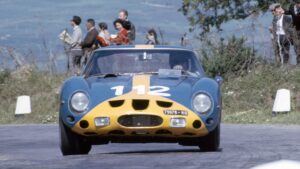 Gioacchino Colombo’s motor was a masterpiece even by V12 standards, powering the vast majority of Ferrari’s road and sports racing cars from the company inception in the late 1940s to the mid- 1960s. Simple, ridiculously reliable but easily tuned, it started life with 1.5 litres in 1947 and ended it 20 years later with 3.3 litres, so stretchable that in all capacities from 2 litres to 3.3 litre it retained the same 58.8mm stroke.
Gioacchino Colombo’s motor was a masterpiece even by V12 standards, powering the vast majority of Ferrari’s road and sports racing cars from the company inception in the late 1940s to the mid- 1960s. Simple, ridiculously reliable but easily tuned, it started life with 1.5 litres in 1947 and ended it 20 years later with 3.3 litres, so stretchable that in all capacities from 2 litres to 3.3 litre it retained the same 58.8mm stroke.
Think Testa Rossa, Tour de France, 166 MM, 250 GTO (left), 275 LM and so many others; this was the engine that powered Ferrari from newbie obscurity to global superstardom. Indeed its first and most recent Le Mans wins were both powered by it. And it didn’t sound bad either…

Lampredi V12
(1951-55)
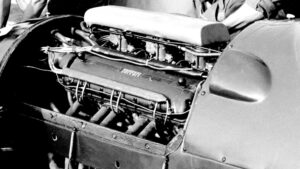 Colombo’s V12 was a great engine, but it never won a grand prix. However, the engine designed by his replacement Aurelio Lampredi did. And it won Le Mans, and it was used in road cars. So while the Colombo motor is Ferrari’s most famous V12, it is Lampredi’s that was its most versatile. Conceived with 3.3 litres, it grew until at 4.5 litres it possessed the power in 1951 to stop the Alfa Romeo steamroller with its (Colombo-designed) 1.5-litre in its tracks. At 5 litres in 1954 it won Ferrari’s second Le Mans. The following year it could be found under the bonnet of the 410 Superamerica. Big, brutal and brilliant to listen to.
Colombo’s V12 was a great engine, but it never won a grand prix. However, the engine designed by his replacement Aurelio Lampredi did. And it won Le Mans, and it was used in road cars. So while the Colombo motor is Ferrari’s most famous V12, it is Lampredi’s that was its most versatile. Conceived with 3.3 litres, it grew until at 4.5 litres it possessed the power in 1951 to stop the Alfa Romeo steamroller with its (Colombo-designed) 1.5-litre in its tracks. At 5 litres in 1954 it won Ferrari’s second Le Mans. The following year it could be found under the bonnet of the 410 Superamerica. Big, brutal and brilliant to listen to.

Ferrari 512/612/712
(1968-71)
By the late 1960s Ferrari engines no longer had a single author, though if this one did, it would be Mauro Forghieri. The engine was conceived as a 6-litre V12 for Chris Amon’s 1969 Can-Am campaign in which it showed some promise against the McLarens.
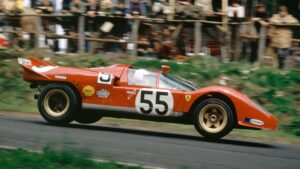 A clutch of podiums resulted before the McLaren became uncatchable. The 7-litre 712 – still Ferrari’s largest engine – fared less well in 1971. But it is best remembered as the 5-litre motor installed in the back of the 512S (left) as Ferrari’s response to the Porsche 917. And, save for one win at Sebring, it failed. So why is it here? Because it’s the quad cam 48-valve racing Ferrari V12 that gave voice to one of the most beautiful cars of all.
A clutch of podiums resulted before the McLaren became uncatchable. The 7-litre 712 – still Ferrari’s largest engine – fared less well in 1971. But it is best remembered as the 5-litre motor installed in the back of the 512S (left) as Ferrari’s response to the Porsche 917. And, save for one win at Sebring, it failed. So why is it here? Because it’s the quad cam 48-valve racing Ferrari V12 that gave voice to one of the most beautiful cars of all.

Matra V12
(1968-74)
Matra built its first V12, the MS9, designed by Georges Martin (above) as a DFV-rivalling motor for the 1968 F1 season. It was such a dismal failure that even by the end of the season it was being phased out in favour of the DFV. Redesigned for 1970 it still struggled against the DFV and Ferrari’s new flat 12, but started to show more promise in a sports car application. And while it was probably never as powerful as the Ferrari engine, it was stronger over distance, finally finding its happiest hunting ground on home soil where, strapped to the back of MS670, it scored a hat-trick of victories at Le Mans from 1972-74. But that’s not why we remember it. Its fame endures because of all the great racing V12s, it was one designed neither in England or Italy that sounds the sweetest. Never heard one? Stop reading and get on YouTube.

BRM V12
(1968-77)
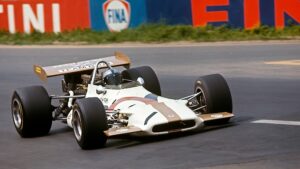 BRM engines tended to be famous for all the wrong reasons: its V16 was hideously unreliable at first and almost impossible for a driver to manage, while its later H16 was complex, heavy and also unreliable. But its V12 was quite the reverse, an entirely conventional design that had a Formula 1 career lasting from 1968-77 – not bad when you consider it had been designed for sports car racing. Indeed it was only drafted into F1 when the H16 turned out to be a dead end. And in Tony Southgate’s effective P153 it had the power to carry Pedro Rodríguez to victory at the pure power circuit that was the old Spa in 1970 (right), then win in Italy the following year in what would reign for years as the fastest grand prix ever run. The following year in rain in Monaco it would also win one of the slowest. Though it raced on, that would be the last win for this long-serving, underrated and sweet-sounding V12.
BRM engines tended to be famous for all the wrong reasons: its V16 was hideously unreliable at first and almost impossible for a driver to manage, while its later H16 was complex, heavy and also unreliable. But its V12 was quite the reverse, an entirely conventional design that had a Formula 1 career lasting from 1968-77 – not bad when you consider it had been designed for sports car racing. Indeed it was only drafted into F1 when the H16 turned out to be a dead end. And in Tony Southgate’s effective P153 it had the power to carry Pedro Rodríguez to victory at the pure power circuit that was the old Spa in 1970 (right), then win in Italy the following year in what would reign for years as the fastest grand prix ever run. The following year in rain in Monaco it would also win one of the slowest. Though it raced on, that would be the last win for this long-serving, underrated and sweet-sounding V12.

McLaren F1 BMW V12
(1995-99)
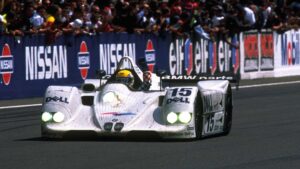 The BMW S70/2 engine was never designed to be a racing unit, any more than was the McLaren F1 road car into which it was fitted. But a change in rules that made it possible for a car like the F1 to win Le Mans outright coupled with the resulting entreaties of customer race teams and the fact the road cars were selling far more slowly than intended made a race programme almost inevitable. And in racing S70/3 configuration it became as revered as it had been in the road car. Powerful, sonorous and incredibly reliable, it helped turn the F1 into the class of the field, taking four of the first five places at Le Mans in 1995, including the top step. McLaren F1 teams took the BPR Global championship in both 1995 and 1996; thereafter the engine found a second lease of life in the back of the BMW LMP1 prototype (right), winning Le Mans again in 1999. Not bad for a road car motor…
The BMW S70/2 engine was never designed to be a racing unit, any more than was the McLaren F1 road car into which it was fitted. But a change in rules that made it possible for a car like the F1 to win Le Mans outright coupled with the resulting entreaties of customer race teams and the fact the road cars were selling far more slowly than intended made a race programme almost inevitable. And in racing S70/3 configuration it became as revered as it had been in the road car. Powerful, sonorous and incredibly reliable, it helped turn the F1 into the class of the field, taking four of the first five places at Le Mans in 1995, including the top step. McLaren F1 teams took the BPR Global championship in both 1995 and 1996; thereafter the engine found a second lease of life in the back of the BMW LMP1 prototype (right), winning Le Mans again in 1999. Not bad for a road car motor…

Mercedes- Benz M154/ M163 V12
(1938-39)
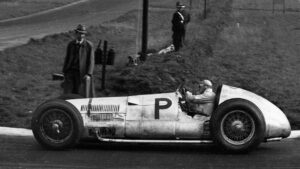 New rules for grand prix racing in 1938 forced a 3-litre capacity upon Mercedes-Benz. No longer could it rely on displacement for power as it had with the 5.6-litre W125, so now it went for cylinders, the old straight eight replaced by a brand new V12. Initially designated M154 for 1938 this engine had four overhead camshafts, four valves per cylinder and was rated at a barely believable 474bhp at 8000rpm, a specific output of 158bhp per litre over 80 years ago, compared to 114bhp per litre for the W125. The following year myriad modifications to the engine resulted in a small increase in power to 480bhp, but fully 500rpm further down the rev range, transforming the engine’s reliability. The result was a car so fast it was beaten just once in each of the seasons it raced, delivering the European Drivers’ Championship to Rudi Caracciola in 1938. But for the outbreak of war, the same title would have been awarded to Hermann Lang (right) the following year.
New rules for grand prix racing in 1938 forced a 3-litre capacity upon Mercedes-Benz. No longer could it rely on displacement for power as it had with the 5.6-litre W125, so now it went for cylinders, the old straight eight replaced by a brand new V12. Initially designated M154 for 1938 this engine had four overhead camshafts, four valves per cylinder and was rated at a barely believable 474bhp at 8000rpm, a specific output of 158bhp per litre over 80 years ago, compared to 114bhp per litre for the W125. The following year myriad modifications to the engine resulted in a small increase in power to 480bhp, but fully 500rpm further down the rev range, transforming the engine’s reliability. The result was a car so fast it was beaten just once in each of the seasons it raced, delivering the European Drivers’ Championship to Rudi Caracciola in 1938. But for the outbreak of war, the same title would have been awarded to Hermann Lang (right) the following year.

Eagle-Weslake V12
(1967-68)
It is commonly, but wrongly, supposed that the Cosworth DFV was the most powerful engine on the F1 grid from the moment it arrived in 1967. In fact this was rarely, if ever, the case throughout its illustrious career. One engine that trumped it was the V12 used by Dan Gurney in the back of his Eagle to win that year’s Belgian Grand Prix (above).
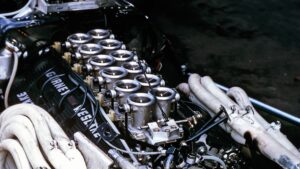 The engine was designed by Aubrey Woods and Harry Weslake and originally intended for BRM, but when the concept with its narrow angle cylinder heads was rejected, Dan Gurney showed an interest. Despite the whole thing being done on a shoestring budget, by the time Dan headed out to Spa it was developing 413bhp, making it arguably the most powerful engine on the grid. By the start of 1968 it was reputedly developing 442bhp but the money had run out, the car raced only sporadically and as the F1 world raced to adopt the light, affordable DFV, its era was over.
The engine was designed by Aubrey Woods and Harry Weslake and originally intended for BRM, but when the concept with its narrow angle cylinder heads was rejected, Dan Gurney showed an interest. Despite the whole thing being done on a shoestring budget, by the time Dan headed out to Spa it was developing 413bhp, making it arguably the most powerful engine on the grid. By the start of 1968 it was reputedly developing 442bhp but the money had run out, the car raced only sporadically and as the F1 world raced to adopt the light, affordable DFV, its era was over.

9 Honda V12
(1964-65)
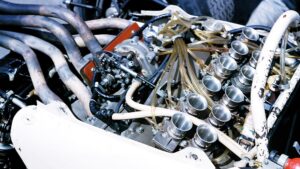 Honda, at the time a company far better known for motorcycles, produced its first V12 at the end of 1964, a jewel of a motor whose dozen 125cc cylinders produced 222bhp at 12,000rpm, just 1000rpm above its torque peak! It was reliable at 13,000rpm, red-lined at 14,000rpm and was once buzzed to 16,000rpm by Ronnie Bucknum without apparent injury. So if you’re ever minded to ponder who made the most powerful engine of the 1.5-litre F1 era, be advised it was neither Coventry Climax nor BRM, nor even Ferrari. It was Honda. Success came at the last minute, Richie Ginther exploiting the Honda’s fuel injection in the thin air of Mexico City to record his and Honda’s first ever grand prix win (above), and the last of the formula in which it was designed to compete.
Honda, at the time a company far better known for motorcycles, produced its first V12 at the end of 1964, a jewel of a motor whose dozen 125cc cylinders produced 222bhp at 12,000rpm, just 1000rpm above its torque peak! It was reliable at 13,000rpm, red-lined at 14,000rpm and was once buzzed to 16,000rpm by Ronnie Bucknum without apparent injury. So if you’re ever minded to ponder who made the most powerful engine of the 1.5-litre F1 era, be advised it was neither Coventry Climax nor BRM, nor even Ferrari. It was Honda. Success came at the last minute, Richie Ginther exploiting the Honda’s fuel injection in the thin air of Mexico City to record his and Honda’s first ever grand prix win (above), and the last of the formula in which it was designed to compete.

Aston Martin V12
(2005-2011)
An engine originally designed by Ford, based on two Mondeo V6 motors that would go on to win back-to-back class wins at Le Mans in 2007 and 2008 in the front of an Aston Martin… The Aston Martin V12 may have had humble origins but Aston Martins raced successfully for years in the top category of GT racing, not just at places like Le Mans but also and for even longer at events like the Nürburgring 24 Hours.
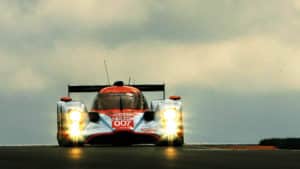 This was an engine of immense durability and longevity, first appearing in the aforementioned Ford concept car in 1996 yet still capable of powering a GT3 Vantage to fourth overall in the N24 some 22 years later. Nor should we forget its role in the back of the Lola-Aston Martin B08/60, sometimes referred to as the Aston Martin DBR1-2.
This was an engine of immense durability and longevity, first appearing in the aforementioned Ford concept car in 1996 yet still capable of powering a GT3 Vantage to fourth overall in the N24 some 22 years later. Nor should we forget its role in the back of the Lola-Aston Martin B08/60, sometimes referred to as the Aston Martin DBR1-2.
It is too easy to forget that in an era dominated by diesel, this road car engine powered what was often the most successful of the petrol prototypes during 2010 (left) and 2011.
